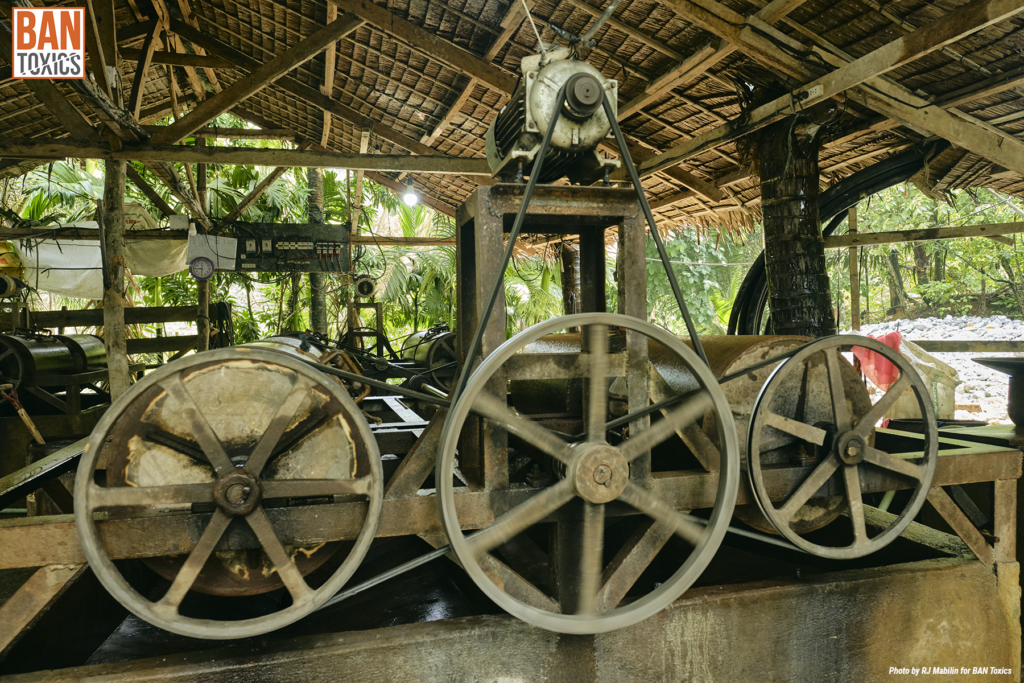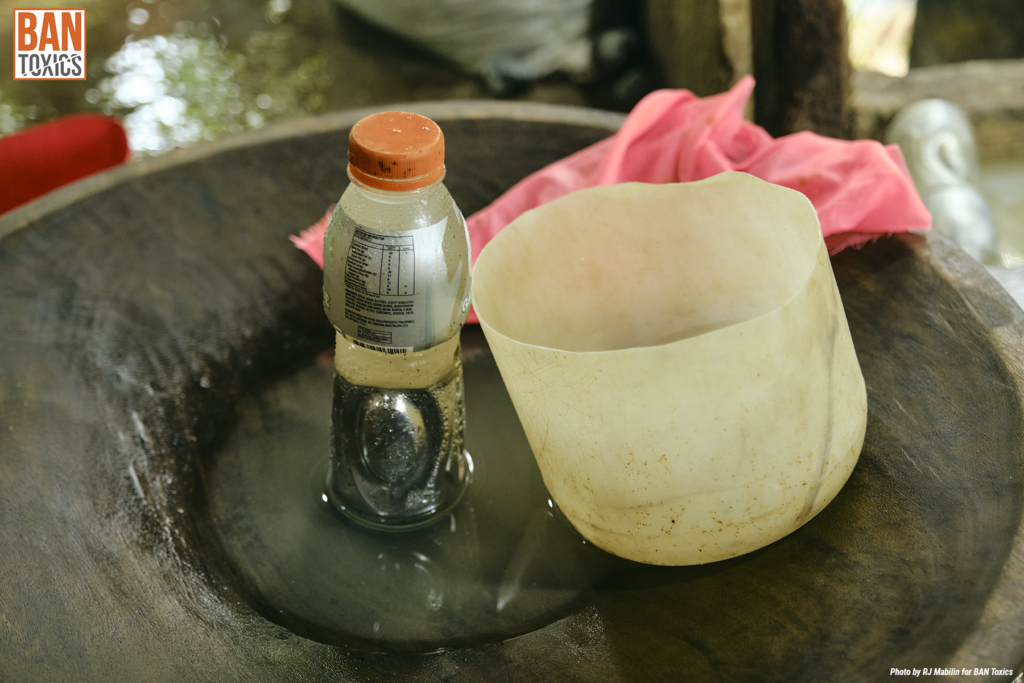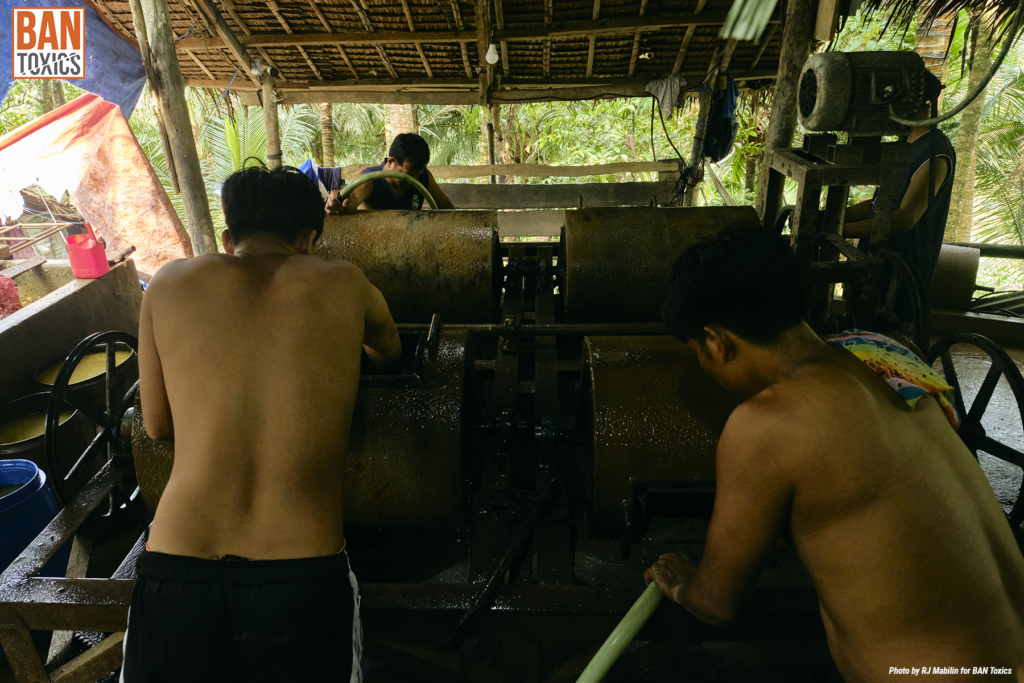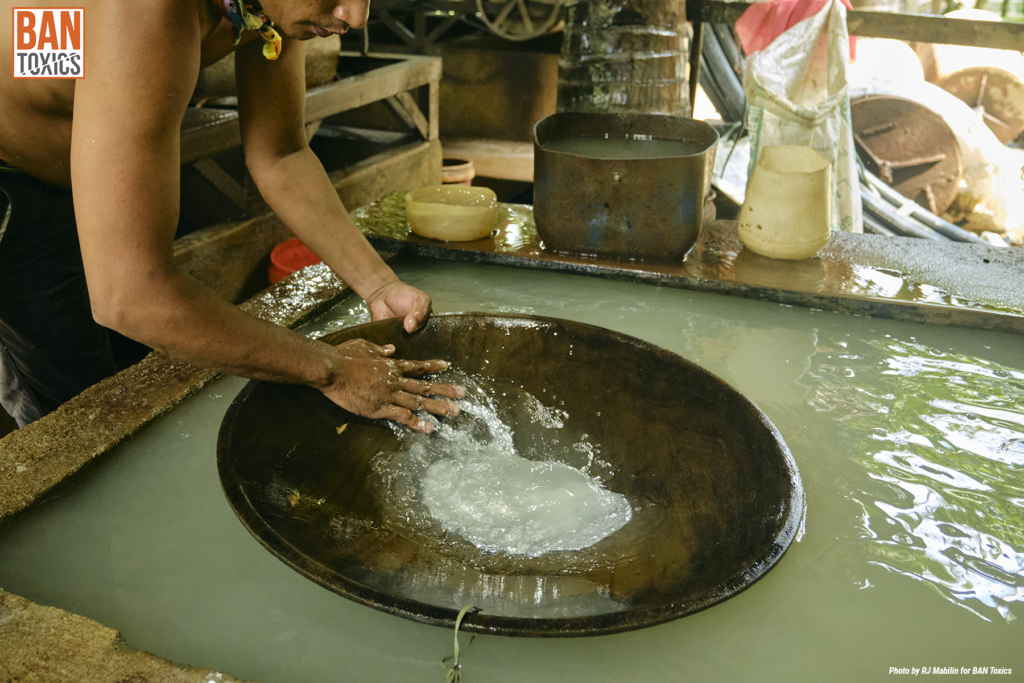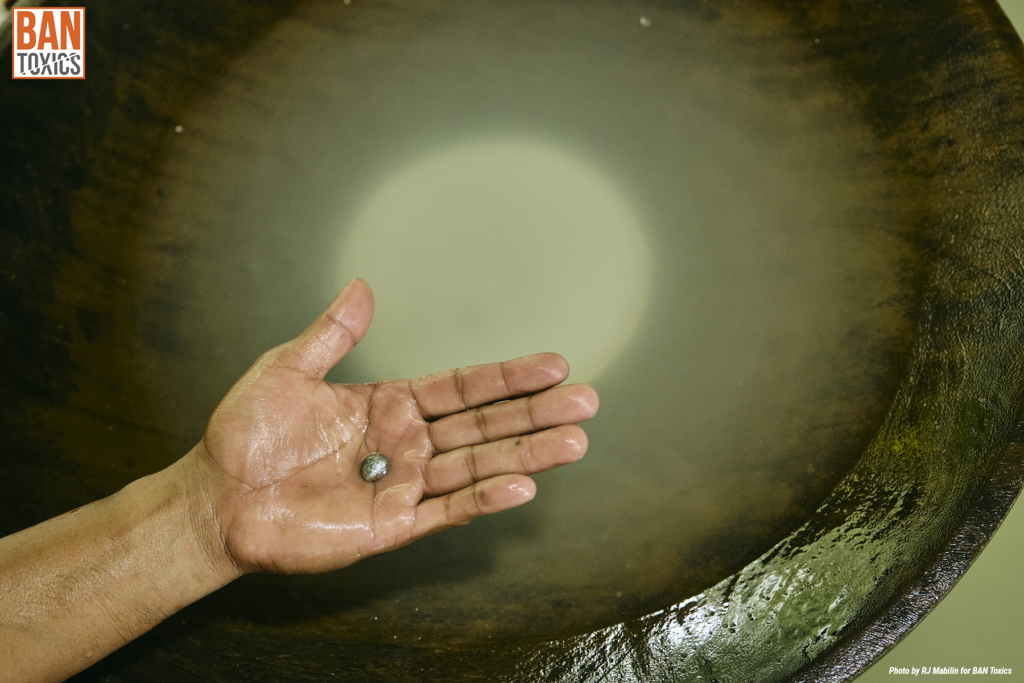
About 340 kilometers south of Manila, Jun (not his real name) took the time to entertain visitors at his small-scale gold mining facility. It was a busy Saturday afternoon, as it usually is at the facility which operates 24/7, but Jun didn’t mind taking some time off to show the visitors around. “Okay lang, hindi naman palaging may bumibisita dito (it’s okay since we don’t always have visitors here),” he said reassuringly.
Amidst the loud and persistent rumbling and clanking of mills crushing ores, he tried to explain the cost of their operation. “Sa calamansi pa lang, gumagastos kami ng Php 100,000 kada buwan (We spend Php 100,000 per month on calamansi alone),” he shared, which would explain the stench permeating throughout the area. He further revealed that they spend about 1 million pesos per month on electricity and buy 40 kilograms of mercury, which at the time, cost around Php 8,000 per kilogram.
One would wonder how much gold this operation extracts in a month with such high operational costs, which don’t yet include the salaries of nearly 100 workers. But that was not the main purpose of the visitors. The last bit of information, the amount of mercury being used in the mining facility, is what the visiting team from the environmental NGO BAN Toxics was primarily after.
BAN Toxics has been at the forefront of the campaign to eliminate mercury and mercury compounds for more than a decade. The group is one of the first NGOs to work closely with artisanal small-scale mining (ASGM) communities, which previous studies have revealed to be the largest source of mercury emissions in the country, as well as globally.
Mercury use in ASGM
Located in Brgy. Luklukan Sur, in the town of Jose Panganiban, Camarines Norte, Jun’s mining operation is just one of about 25 other facilities in the barangay. It is an open secret that mercury use in ASGM operations in Jose Panganiban and the nearby mining towns of Paracale and Labo continues to this day. In fact, the majority of ASGM facilities all over the country use mercury in their operations.
Mercury is used in mining to capture gold from milled ores. The process may vary, but in Jun’s facility, different amounts of calamansi juice and one Gatorade bottle cap of mercury, approximately 136 grams, are added to each ball or rod mill, which contains 1 to 1.5 sacks of crushed ore. After 1 to 1.5 hours of grinding, the drums are washed with a pressurized hose, and a slurry of the mercury-containing gold sediments is collected. Using a wooden pan, the slurry undergoes panning and is washed a couple more times to remove impurities. The slurry is then filtered through a small piece of cloth that is squeezed to isolate the gold-mercury amalgam. The amalgamation process is repeated on the remaining slurry to capture more gold, while the remaining mercury is recovered and reused.
Later, all of the acquired gold-mercury amalgam will be smelted in the same facility, yielding the final gold product. This process releases mercury into the air.
The Minamata Convention on Mercury
Mercury, locally called “asoge,” is a highly toxic, naturally occurring heavy metal. It is a neurotoxin that can cause irreparable damage to the nervous system. Prolonged exposure to mercury may also harm the eyes, lungs, kidneys, digestive, and immune systems. Infants, children, and developing fetuses are particularly vulnerable to its harmful developmental effects, including brain damage, hearing, and vision problems.
Mercury is indestructible, which means it will forever persist in the environment. It can accumulate in living organisms and biomagnify in the food chain. Releases and emissions of mercury can therefore contaminate entire ecosystems.
Mercury use in ASGM is strictly prohibited under the Department of Environment and Natural Resources (DENR) Administrative Order 2019-20 (DAO 2019-20), as well as the Minamata Convention on Mercury, to which the Philippines is a party.
On July 8, 2020, the Philippine government ratified the Minamata Convention, the first legally binding global treaty designed to protect human health and the environment from man-made emissions of mercury and mercury compounds.
The Convention was named after the mercury contamination in Minamata Bay, Japan, in the 1950s, which resulted in an epidemic among residents around the bay of what is now known as Minamata disease, which affects the central nervous system. Over two thousand people died in the tragedy, while thousands more experienced crippling injuries.
The Convention’s provisions address the entire life cycle of mercury, including controls and reductions across a range of products, processes, and industries where mercury is used, released, or emitted.
But four years after the ratification, mercury-use in Camarines Norte remains widespread.
Poverty-driven industry
In 2019, BAN Toxics published a study which assessed the factors contributing to the continued use of mercury in the ASGM. Titled “Illicit Mercury Flows and Governance Practices in Mindanao, Philippines,” the study identified the poverty-driven nature of ASGM and the lack of government support as the primary reasons, among others.
The paper states: “The majority of small-scale miners in the Philippines are engaged in subsistence mining. As much as 75% of the total ASGM population barely earn enough for the day’s needs, e.g., miners usually only earn enough to buy food, water, and other needs on any given day. On days where no gold is produced, miners and their families will be left with no money to purchase food. For most miners, they are left with no choice but to accrue significant debts to provide for their families.”
According to Arlene Galvez, adviser to the Samahang Magkakabod ng Camarines Norte (SAMACANO), the provincial federation of small-scale miners, while there are existing mercury alternatives to capturing gold, the subsistence nature of the sector discourages them from using such methods.
“Yung mga alternative gaya ng cyanidation ay nagre-require ng mahabang oras. Hindi katanggap-tanggap sa mga minero na maghintay ng araw o buwan na ipunin yung mga nakuha nilang bato at hintayin yung volume na kailangan para makapagsalang ka sa mga plantang ito (Alternatives like cyanidation are time-consuming. It is not viable for miners to wait days or months to accumulate the required volume of ores to be able to process via these [cyanide] plants),” Galvez said, adding that the method is also costly.
Cyanidation is one of the mercury-free alternatives available right now for gold extraction. Though also highly toxic, cyanide does not persist in the environment.
Jam Lorenzo, author of the aforementioned study and BAN Toxics Policy Development and Research Officer, cites that insufficient support from the government also translates to the lack of opportunities for miners to access safer technologies.
“ASGM remains largely informal, with the majority of mining communities in the country operating illegally. As such, miners have little or no access to basic social services and are victimized by corruption and extortion, which further contributes to the cycle of poverty,” Lorenzo adds.
Formalization of ASGM
BAN Toxics advocates for the formalization of the ASGM sector, seeing it as an essential step toward proper government support and accessible mercury-free technology. Formalization means miners are licensed to operate within a declared “Minahang Bayan” or People’s Small-Scale Mining Area. This requires small-scale miners to follow environmentally responsible practices, comply with regulations, establish committees to oversee operations, promote development, and provide livelihoods while protecting the environment.
“But the approval of Minahang Bayan itself is extremely challenging due to the exorbitant costs of mining applications, the limited validity of mining contracts, and bureaucratic red tape,” Lorenzo said, adding that a mining contract typically requires approximately 1 million pesos to meet the stringent requirements set by the DENR-Mines and Geosciences Bureau (DENR-MGB).
Based on the latest Mining Industry Statistics released on March 11, 2024 by the DENR-MGB, there are currently 58 approved and registered Minahang Bayan and 167 ongoing applications nationwide. In Camarines Norte, there are 3 registered and 32 pending Minahang Bayan applications, according to Galvez. One mining association in Jose Panganiban has yet to get their Minahang Bayan permit and small-scale mining contract despite having spent over 5 million pesos since 2014.
Meanwhile, Lorenzo noted that formalization should go hand-in-hand with other programs addressing poverty and other social services, as well as enforcement of laws and regulations, especially on the entry of illegal mercury and mercury-added products in the country.
Illegal Trade
Lorenzo pointed out that since the Palawan Quicksilver Mines closed in 1976, there have been no mercury mining operations in the country. “Evidence indicates that mercury in the Philippines comes from neighboring countries like China, Indonesia, and Malaysia, entering the country through both illegal and legal channels.”
Galvez meanwhile remarked that while there are suppliers of mercury in ASGM communities, there will be buyers. “Tanong din ng mga minero na kung bawal pala [ang mercury] bakit may nagbebenta na mga kilalang personalidad sa community at mayroong authority (Miners also wonder how, despite being illegal, those selling mercury are known personalities and persons of authority in the communities.)”
Article 3 of the Minamata Convention does not allow the import of mercury without government consent, ensuring that both the mercury source and proposed use comply with the Convention and applicable domestic law.
“Addressing the transboundary trade of mercury remains a significant challenge for the country, not just in ASGM but also with other mercury products. To this day, BAN Toxics monitors the continued entry of imported mercury-containing beauty products, which are sold cheaply in both online and physical stores,” Lorenzo said.
Moving Forward
On June 7, 2024, Galvez held a workshop on mercury toxicity for new officers and members of SAMACANO and Department of Labor and Employment (DOLE) labor inspectors in Daet, Camarines Norte. Jun, was also in attendance.
Galvez said that despite the persistence of mercury-use in Camarines Norte, what’s changed now is the level of awareness in communities with regards to mercury. “Mas aware na sila ngayon na kailangan maalis ang mercury, compared to, sabihin na natin,10 years ago. Pero ang hinahanap lang talaga nila ay yung alternative na makakatugon sa pangangailangan ng mga magkakabod (they are more aware now on the need to eliminate mercury, let’s say, compared to 10 years ago. But they are really just looking for alternatives that will still meet the needs of the miners.)”
SAMACANO president Rolando Persia spoke at the workshop about gravity concentration method, a mercury-free alternative to capturing gold that they use in their operations in Brgy. Malaya, Labo.
Gravity concentration is a natural method of separating gold from milled ores by sluicing and skilled panning using a metal pan. Sluices are inclined, flat-bottomed troughs lined with a trapping mechanism to capture gold particles. According to Persia, this method has a gold recovery rate of 75% to 90%.
By the end of the workshop, Jun and other mining financiers who still use mercury expressed interest in being trained in the gravity concentration method, to which Persia agreed.
Persia said that as much as they want to train everyone on their method, they cannot do it alone. “Dapat bumaba ang mga tiga-gobyerno sa mga magkakabod at tumulong sa pagtuturo ng mercury-free [alternatives] (The government should go to the miners directly and train them in mercury-free [alternatives]).
The workshop is part of a series of activities in preparation for the upcoming 5th National Assembly of the National Coalition of Small Scale Miners in the Philippines. Inc, (NCSSMPI) to be held on July 24-27, 2024, in Camarines Norte.
NCSSMPI was founded in 2016 after the 4th National ASGM Mining Summit hosted by BAN Toxics, with the goal of promoting responsible small-scale mining, including sustainable mercury-free methods. Currently, the NCCSMPI has more than 40 small-scale mining associations from across the country as its members, with BAN Toxics serving as the secretariat.
One of the the main goals of the 5th Assembly is updating proposed amendments to RA 7076, the “People’s Small-Scale Mining Act of 1991,” and the National Action Plan for Small-Scale Miners.
According to Lorenzo, the 33-year-old RA 7076 is outdated and in need of amendment that would “strengthen the provisions on the prohibition on the use of mercury by providing adequate economic and institutional support to miners that encourage the shift to mercury-free technologies and protects them from exploitation and abuse from stakeholders who benefit from the illicit mercury trade.”
The proposed amendment also includes streamlining the application process for the declaration of Minahang Bayan areas and approval of small-scale mining contracts, among other changes.
“It is our hope that the 5th Assembly will further strengthen the Coalition and drive small-scale miners forward to a mercury-free future,” Lorenzo concluded.
Currently, BAN Toxics is working on other projects related to mercury, including continuous market monitoring of mercury-added products, research on the mercury material flow in the country, and the Philippine Healthcare and Mercury Wastes Management Project, which plans to assess the status of mercury-containing medical devices and assist in their final disposal.
For now, Jun continues to find the risk of using mercury worth its weight in gold.
This piece was written by RJ Mabilin, BAN Toxics Communications Officer.
References:
https://bantoxics.org/wp-content/uploads/2021/04/MercuryPrimer.pdf
https://emb.gov.ph/wp-content/uploads/2022/09/Minamata-Convention-on-Mercury.pdf
https://bantoxics.org/wp-content/uploads/2020/04/IUCN-Report-Final-Layout-Press-Quality2020.pdf
https://chemical.emb.gov.ph/wp-content/uploads/2019/11/DAO201920MERCURY.pdf
https://businessmirror.com.ph/2017/05/22/villar-legalize-small-scale-mining/
http://databaseportal.mgb.gov.ph/#/public/minahang-bayan

